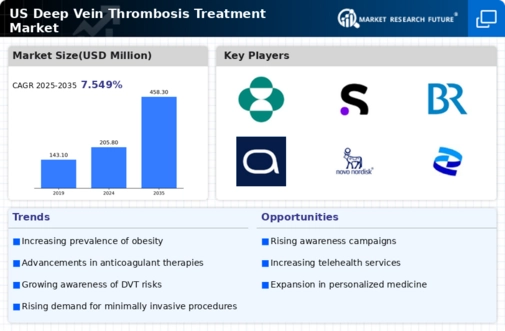The US Deep Vein Thrombosis Treatment Market is characterized by a dynamic and competitive landscape driven by the increasing prevalence of chronic conditions that lead to DVT, such as obesity, cancer, and prolonged immobility among patients. Various pharmaceutical companies and healthcare providers are focusing on advanced therapeutic solutions and innovative drug formulations to enhance patient outcomes. The market is primarily segmented into medication types, including anticoagulants and thrombolytics, and is influenced by the evolving treatment guidelines, increased patient awareness, and the growing burden of cardiovascular diseases.
As the healthcare industry emphasizes value-based care, competition among key players intensifies, leading to the development of novel treatment options, investment in research and development, and strategic collaborations to capture market share. Merck has a strong foothold in the US Deep Vein Thrombosis Treatment Market, primarily recognized for its widely prescribed anticoagulant therapies. The company has established itself as a leader through a robust pipeline of innovative drug formulations that address critical aspects of DVT management. Merck's strengths lie in its extensive research capabilities and the high safety and efficacy profile of its products.
The firm has effectively leveraged partnerships and collaborations to enhance its market presence, engaging in initiatives that focus on clinical evidence supporting its treatment options. This approach has not only strengthened Merck's position within the DVT segment but has also facilitated deeper penetration into various healthcare institutions across the US, allowing for better accessibility of its therapies to healthcare professionals and patients alike. Sanofi is a prominent player in the US Deep Vein Thrombosis Treatment Market, known for its effective anticoagulant options designed to prevent and treat DVT.
The company has a strong market presence bolstered by its commitment to research and innovation aimed at developing therapies that cater specifically to the needs of DVT patients. One of Sanofi's key strengths is its established product portfolio, which includes well-recognized medications that have proven to be effective in managing DVT and its complications. Furthermore, Sanofi has been active in mergers and acquisitions, strategically acquiring companies and products that enhance its therapeutic offerings within the US market.
These strategic moves not only expand its product lineup but also increase its competitiveness by providing comprehensive solutions for DVT treatment, underlining the company’s dedication to improving patient outcomes and solidifying its leadership status within this therapeutic area.















